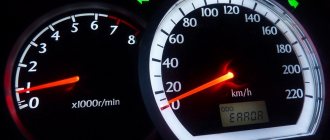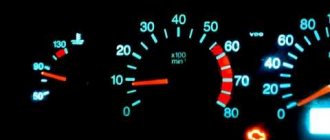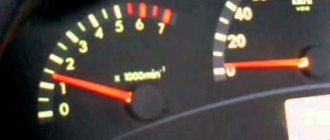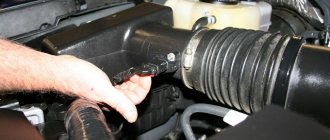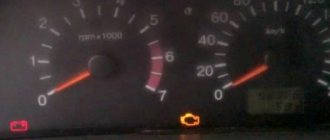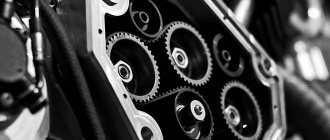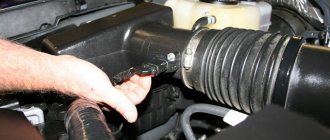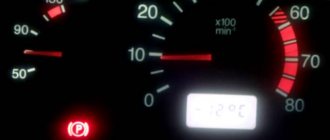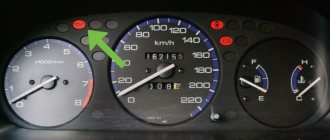The situation with floating speed (jumps) is associated with problems with the automatic power supply system. This occurs on engines equipped with electronic fuel injection. As a rule, the cause of this is excess air entering the combustion chamber.
The electronics (computer) does not have time to calculate the proportion of the fuel mixture entering under the piston. Moreover, the electronics may lose control of the throttle and temperature sensors. This changes the speed in the range of 800÷1500 for only 3 seconds , but is enough to distort the stable idle speed.
Floating diesel speed is often detected by tightening the adjustment screw and closing the air access hole.
The method promotes stable idle speed. Otherwise, there is a need for a proven method of blocking rubber tubes with round pliers.
Causes of floating idle
The car owner will know that the engine has a malfunction with idle speed violation from the tachometer readings. During normal operation of the power unit in idle mode, the speed indicator needle is in one position, most often in the range of 750-850 revolutions, depending on the make of the car. If a malfunction occurs in the engine, the tachometer needle begins to jump up and down in the range of 500-1500 rpm, and sometimes more.
If the car does not have a device such as a tachometer, then the jumping speed can be determined by ear. The sound of the engine running becomes louder and quieter. Uneven idling is also determined by increasing and decreasing vibration entering the vehicle interior from the engine compartment.
There can be many reasons for unstable idle speed in engine operation. Modern cars are constantly becoming more complex in their maintenance and design. Usually, without special diagnostic equipment, a malfunction cannot be immediately identified. Many different sensors and electronic systems, a software shell and its own information transmission network become part of the design of modern cars, which greatly complicates diagnostics and repairs at home.
The reasons for the malfunction of the motor can be quite natural and common. The most common main causes of engine idle failure, which can be determined without auxiliary equipment, are:
- Crankcase ventilation leakage.
- Reducing compression in several cylinders.
- Low fuel pressure in the fuel system.
- Faulty spark plugs.
- On fuel-injected cars, the injectors become dirty.
- Air leak in the intake system.
Complex faults requiring the intervention of diagnostic service workers:
- The air flow sensor is faulty or dirty.
- The ignition coils or switch are faulty.
- The crankshaft or camshaft sensor is faulty.
- The idle speed sensor does not work in the required mode.
- Malfunctions of the electronic engine control unit.
This is not a complete list of reasons for idle instability, but only the most common problems.
Most often, uneven engine speed occurs at idle. However, in intermediate modes, the engine may also operate with dips or sudden increases in speed, which is most typical for diesel engines. Let us consider these issues separately in more detail.
Intake system leakage
Floating idle speed is most popular on cars equipped with injection engines. This is due to the way the idle speed is adjusted by the engine's electronic system. The electronic brains of the car periodically read data about the operation of the engine at idle, and if it is violated, they issue a signal to the corresponding sensors to correct this situation for correct operation.
Idle speed can be disrupted from normal functioning due to the penetration of excess air into the fuel supply system, namely into the engine cylinders. In this situation, the air flow sensor sends a signal to the electronic unit that excess air is entering the engine.
To equalize the volume of air and fuel that creates a jointly combustible mixture, the electronic unit sends a signal to the injector valves to open more and allow more fuel into the cylinders. At the same time, the engine speed increases sharply. Next, the electronic system receives information that a lot of fuel has entered the cylinders and reduces its supply, which immediately reduces the speed.
Checking the operation of this sensor is quite simple. You need to remove the plug from it and start the engine. If after this the speed stabilizes and the power increases, this indicates that the sensor is working properly. Leaky connections in the intake pipes can be detected by supplying compressed air with a pressure of about 0.5 atmospheres into the intake system while the engine is not running. If there is an air leak, it is easily detected by a hissing sound.
Idle speed control
The cause of floating idle speed may be the failure of this device. It is made in the form of an electromagnet, the device of which includes a needle with a conical tip. Its task is to equalize engine speed during idle.
The main reason for its failure is the wear of its parts: wire breakage, wear of the needle drive or guides due to prolonged operation on low-quality gasoline. If the regulator is faulty, the motor begins to increase or decrease speed.
Crankcase ventilation valve
During engine operation, exhaust gases, called crankcase gases, accumulate in the crankcase. A new engine produces little crankcase gases, but an engine with significant mileage has a fairly large volume of crankcase gases. Excess of these gases is discharged through the valve into the ventilation system, and then into the intake system and to the throttle valve. Crankcase gases are an integral part of the combustible mixture entering the engine.
When this valve jams due to the large accumulation of oil deposits in the oil gas, a smaller volume of crankcase gases passes into the intake system, and the combustible mixture is not enriched enough. As a result of this, the engine speed at idle begins to float from 750 to 1100.
The crankcase ventilation system is a complex device and consists of many pipes and valves. All of them can break down and become clogged over time. Periodic maintenance of this system ensures stable operation of the engine and reduces fuel and oil consumption. During a routine inspection, a malfunction of this system can be identified in a timely manner. Problems are identified by large amounts of smoke in the engine compartment, as well as contamination of the engine.
Finding out the reason for the floating speed on a hot engine is quite simple. With the engine running, open the oil filler neck and lift it up. If the engine operation has changed, then you should look for a malfunction in the crankcase ventilation system.
Air flow sensor
It often happens that the air flow sensor, which is briefly referred to as mass air flow sensor, fails.
It, just like the previously discussed regulator, fails due to oil deposits during long-term use, which leads to a disruption in its performance. Very rarely, the hot-wire anemometer in the air flow sensor fails. This is the element that is responsible for measuring the amount of air passing into the combustion chamber of the engine. In this case, the electronic unit will not receive true data on air mass consumption and gives a signal to supply it to the cylinders, which leads to a floating engine speed.
Throttle valve
The task of this device is to regulate the air pressure that enters the engine cylinders. It can jam for several reasons:
- Oil deposits accumulate inside the damper itself, preventing the damper from opening and closing to the required amount.
- Jamming can also occur due to a malfunction of the drive of this damper.
The most common cause of unstable engine idle speed is for carburetor cars. Considering carburetor engines, we will determine the reasons that cause differences in idle speed.
- Incorrect idle speed adjustment.
- Solenoid valve malfunction.
- The idle air jet is clogged with carbon deposits.
Injector malfunction
On diesel and gasoline engines, fuel injection is similar in effect. The injector sprays fuel into the cylinder under a pressure of 1 atmosphere. If the nozzle becomes clogged, the fuel is sprayed unevenly and the geometry of the spray pattern is disrupted. This leads to uneven engine operation, reduced power and floating speed.
You can find out that the injectors are clogged with your own hands. To do this, the fuel rail is dismantled together with the injectors and removed from the engine. This method is not suitable for all cars. The system is under pressure connected to the fuel line. In this case, all injector nozzles are visible. Next, you need to turn on the ignition and crank the engine several times using the starter. An injector with an incorrect pattern will be immediately visible. It must be removed and washed. Before removal, be aware of the presence of high pressure in the fuel rail.
Checking the spark plugs
These details require constant attention. Their service life may vary, depending on the material used to make the electrodes. It can be iridium, platinum or nickel. Spark plugs with nickel electrodes fail most quickly; they are most often changed together with engine oil. The distance between the electrodes increases, they burn out, and as a result, a “wandering spark” appears, ensuring unstable ignition of the combustible mixture in the cylinders.
Visual inspection of spark plugs makes it possible to determine their performance, as well as the quality of the fuel mixture. If the spark plug is damp and the electrodes are oily, it should be replaced. However, the fault may not be in the spark plug at all, but in the ignition coil.
The quality of the fuel can be determined by the color of the carbon deposits on the threads and electrodes. Brown color is considered normal. A clean and dry candle indicates its serviceability. There should be no orange signs of overheating on the ceramic insulator. If the metal parts of the candle are black or white, then the mixture formation is incorrect. Most often the problem occurs in the air intake system.
Reduced fuel pressure
Gradually, the fuel pump produces less and less pressure, which is no longer enough for the normal functioning of the power unit. The pump may operate intermittently, causing pressure to be created unevenly and disrupting the stability of fuel injection. The tightness of the joints between the fuel line and the pump is also compromised, which is determined by visual inspection. There are other reasons for a decrease in fuel pressure. If fuel filters are not changed on time, this will lead to difficult passage of fuel to the injectors and high load on the pump.
When replacing the fuel filter, pay attention to the direction of fuel flow, which is indicated by an arrow. Filters may have a pressure regulator that sometimes stops working or is not installed correctly. When installing the fuel filter, do not forget about increased pressure in the system.
Low compression in cylinders
The machine engine must always be dry and clean. Constant care of the surface of the power unit will help to promptly identify various leaks of operating fluids, arrive at a car service center on time and avoid unnecessary expenses. It is especially important to detect engine oil leaks in time. There are many reasons for this, which could be worn out oil seals, pan gaskets and valve covers, as well as spark plug wells. However, we are looking at reduced compression due to a bad head gasket. A large leak of oil coming out of the engine under pressure is immediately visible on its surface.
Damage to the gasket leads to uneven operation of the power unit and penetration of coolant into the engine oil, as well as to water hammer and warping of the cylinder block. Replacing a damaged gasket in a timely manner will prevent your machine from suffering serious problems and keep it dry and clean.
Instability of speed in intermediate modes
In diesel power units, floating speeds in operating modes most often appear due to the formation of corrosion on the plungers of the high-pressure fuel pump. Rust on these parts appears due to the presence of water in the fuel. Because of this, the diesel engine speed fluctuates even at idle.
The consequences of these considered reasons are:
- High fuel consumption.
- Release of a large amount of carbon monoxide into the external environment.
- Wear of parts of the fuel system and air supply to the engine.
To prevent such consequences, it is necessary to regularly check the functioning of the considered sensors and systems. If a malfunction does occur, you should immediately take measures to repair it.
The considered reasons for floating engine speed are only the main ones, and there are many other reasons. They will help you understand the operation of the car and prevent unnecessary spending of money on auto repair shops. Without understanding the operating features of the power unit, we may be subject to fraudulent actions by car repair specialists. Often, cheap repairs turn into large financial expenses that could not have been made. You should study in more detail the structure and operation of your machine, and it will answer you with a long service life.
Methods for solving the problem
Having detected a floating speed, experienced drivers begin checking the relevant electronics. During diagnostics, special attention is paid to the throttle assembly, as well as sensors and actuators. The operation of other mechanisms also needs to be diagnosed, including the ignition system and idle speed control, as well as air and fuel filters, injector nozzles, etc. There is especially a lot of hassle with the regulator and air flow sensor. Based on the results of a thorough diagnosis, it often turns out that the whole reason is a heavily contaminated throttle valve, which for this reason does not close as it should, or mechanical damage to the throttle. In the first case, careful cleaning of the valve immediately gives a positive result, but in the second case it is best to replace the throttle with a new one.
How to stabilize floating speed
- Penetration of foreign air into the engine . It is necessary to check the tightness of the air system channels with the intake manifold. For such purposes, it is necessary to dismantle each hose separately and pump it with a pump or compressor, but you can try spraying liquid -40 on the hoses, where it will quickly evaporate; there is most likely a crack in the hose. In such a situation, it is better to replace the damaged hose with a new one rather than wrap it with electrical tape.
- Replacing the IAC . The condition of this device is checked with a conventional multimeter, which needs to check its resistance. If the resistance readings are in the range of 40-80 Ohms, the regulator is faulty and such a device requires immediate replacement.
- Cleaning the valve and elements of the engine ventilation system . In this case, you will have to disassemble the oil sump and get to the ventilation valve. It should be pulled out and washed in a product for cleaning engine elements from an oil film. You can use regular kerosene. Next, dry the valve thoroughly and then put it in its place.
- Replacing the air flow sensor . This is the most delicate part and most often cannot be repaired. Therefore, if the cause is the air flow sensor, then it is advisable to replace it. It is known from practice that even professionals cannot repair a hot-wire anemometer.
- Flushing the throttle valve and then installing it in the correct position . There are two methods for cleaning the throttle valve from oil contaminants: without removing it from the car, and also with removing the throttle valve. When removing the damper from the car, you must disconnect all wires and hoses from the damper, loosen it and pull it out. Next, place it in a container and fill it with cleaning aerosol. If the oil stains on the surface of the throttle valve are already old, you can clean them with a brush. Next, dry the damper surfaces with a rag and put them in place, connecting all the wires and hoses. If the damper is not removed from the car, then it can be washed on a hot power unit with a similar aerosol. Before spraying cleaning agent, disconnect power from the throttle valve. First you need to pour the product inside the throttle valve, wait a few minutes and start the engine. With the power unit operating, continue cleaning the damper with the same product. If, during such cleaning, white smoke comes from the damper, then this is normal, since oil contaminants are cleaned in this way. At the end of the work, you should connect the wires and adjust the operating order of the throttle valve on the computer, setting the required opening gap.
- Idle speed adjustment . This procedure can be carried out using a regular screwdriver, adjusting the screws for the quality of the fuel mixture and the number of engine revolutions.
- Replacing the solenoid valve . If the carburetor idle valve malfunctions, the engine can only operate when the choke handle is pulled out. Therefore, in order to prevent idle speed fluctuations, it is advisable to replace the valve with a known good one or a new one.
- Cleaning the idle air jet . Even in the old days, cleaning the jet from oil deposits was considered a very labor-intensive task. Currently there is no need to remove the jet from the carburetor. To do this, you just need to pour a specialized product into it, designed for cleaning carburetors, and wait in this state for several minutes. Then you need to clean the nozzle from dirt using compressed air.
- Treatment of parts of the fuel pump on a diesel engine from rust . To perform this task, you will need a specialized corrosion cleaning agent. This can be either an imported or a domestic product. It is simply sprayed into the fuel tank by opening its neck before refueling with diesel fuel at a gas station. The cleaning agent will clean the pump parts from rust on its own. In order to prevent similar corrosion of the high-pressure pump in the future, it is recommended to pour a glass of motor oil into the tank, which can form a protective film on the surface of the pump parts when moving.
You need to know that if uneven engine speed occurs at idle, you must immediately contact a service station and carry out detailed diagnostics of the operation of all engine systems. Timely detection of faults will protect you from costly repairs.
IAC sensor
The cause of engine operation deviation from normal parameters may also be a malfunction of the idle air control sensor (IAC). The whole point is that in cars, as a rule, it is not supplemented by a self-monitoring system, so on-board computers or check-angers do not signal its breakdown. However, floating speed is one of the key signs of a malfunction of the IAC sensor, so it needs a thorough inspection and, if necessary, its repair or even replacement, especially since its cost is relatively low.
